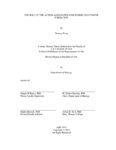TO
1 - 25 of 6
| Creator | Title | Description | Subject | Date | ||
|---|---|---|---|---|---|---|
| 1 |
 |
Evans, Kathryn S. | Defining the interaction between ETV4 and mediator subunit MED25 | Chromosomal rearrangements resulting in an overexpression of a subset of ETS transcription factors (ETV1, ETV4, ETV5, and ERG) are found in over 50% of prostate cancers (Tomlins et al., 2005). ERG and ETV1 have both shared and distinct gene targets, yet overexpression of ETV1 is often found to be as... | Transcription factors; Prostate -- Cancer -- Genetic aspects; ETV4 | 2015-05 |
| 2 |
 |
Chen, Jason J. | Dissecting the genetic and learned components of oscine birdsong | The interplay of genetically encoded and learned components in the development of the learned vocal signals of birdsong and human speech in not fully understood (Forstmeier et al, 2009). The fact that song is a learned vocal behavior does not imply the lack of a genetic basis in acquiring vocalizati... | Birdsongs -- Research; Songbirds -- Genetics -- Research; Zebra finch -- Research; Nature and nurture -- Research; birdsong; Taeniopygia guttata | 2015-12 |
| 3 |
 |
Kutschke, Michael | Hip joint center differences between dual fluoroscopy, functional hip, and coda - establishing a reference standard | Measurements of joint angles, moments, and forces may be highly sensitive to positional changes in the center of a joint. Due to its deep location, the human hip joint center (HJC) can be difficult to determine. Previous studies have defined the HJC relative to external landmarks using infrared moti... | Hip joint; Hip joint center | 2015-05 |
| 4 |
 |
Shimko, Tyler | Mapping suppressors of premature sperm activation in C. Elegans | The sperm of the roundworm Caenorhabditis elegans move by a crawling motion, in contrast to mammalian sperm, which exhibit a swimming motion. This method of locomotion makes the sperm of C. elegans an excellent model for examining cell motility. In order to become motile, the sperm must undergo the ... | Caenorhabditis elegans -- Spermatozoa; Sperm activation | 2015-05 |
| 5 |
 |
Wang, Zhirong | The role of the autism-associated gene kirrel3 in synapse formation | Alterations in the gene Kirrel3 are repeatedly associated with intellectual disability and autism. Kirrel3 regulates synapse formation in C. elegans but the role of Kirrel3 in synapse formation in the mammalian brain is unknown. In mice, Kirrel3 is expressed in specific cell types throughout the bra... | Autism -- Genetic aspects; Synapses; Kirrel3 gene; Synapse formation | 2015-04 |
| 6 |
 |
Skedros, Gregory Athanasios | Structural and material changes in the sheep radius from newborn to adult: Functional adaptation versus developmental constraint | Bones that exhibit marked changes in structural and material characteristics during ontogeny are potentially useful for studying the mechanisms that produce functional adaptations. The diaphyseal region of the sheep radius was examined because it is relatively simply loaded in cranial-caudal bending... | Functional adaptations - Sheep; Developmental constraint - Sheep; Ontogeny | 2015-08 |
1 - 25 of 6
